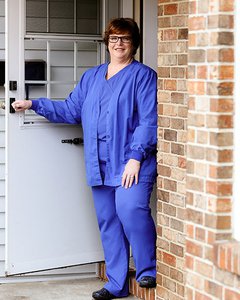Spinal navigation equipment in spinal stenosis procedure helps an SBL nurse regain her mobility.
As a busy nurse, Beth Kitchen often spent her entire 12- hour shift—or longer— on her feet, moving patients and transporting equipment. Over time, the strain on her lower back sent shooting pains down her legs.
“I just couldn’t do my job anymore,” Beth said. That was five years ago, when she was diagnosed with severe spinal stenosis. Spinal stenosis is a narrowing of the spaces along the spine, which can put pressure on the nerves that travel through the spine. It is an incredibly painful condition. Beth ultimately had surgery in which a “cage” was placed, along with four screws and rods, in the impacted area of her spine to create space between the discs and relieve the pressure on the nerves.
The stenosis forced Beth to leave critical care nursing, at which point she became a nursing house supervisor at Sarah Bush Lincoln. In her new role, Beth provided overnight support throughout the organization. “I really enjoyed [hands-on] nursing. I worked in Critical Care and really enjoyed the patient interaction. I was learning new things all the time and I liked that, but my condition put an end to that,” Beth explained.
Unfortunately, the pain returned as the stenosis crept further up the spine. Beth chose conservative treatment, first trying physical therapy, interventional pain management and then steroid injections.
A second surgery was the last option for her, but when the time came, Beth sought care from Neurosurgeon Emilio Nardone, MD, who used spinal navigation equipment to give Beth the best possible outcome. The technology provides an image-guided open navigation platform to deliver more accurate screw placement than conventional surgical techniques. Information from an MRI is loaded into the system, which then places markers on the spine to ensure the surgeon only cuts within set parameters. Dr. Nardone has been using the technology at Sarah Bush Lincoln for the past year.
Having had the surgery in July 2019, Beth continues to recover with limited but decreasing weight restrictions. “I feel like I’m recovering much better after this second surgery. I used less pain medications than with the previous surgery,” she conceded.
Beth has a strong motivation to follow Dr. Nardone’s instruction. Not only was she losing her mobility and the ability to do the work she loved, she found it difficult to play with her grandchildren.
“[Before the surgery] our daughter and son-in-law worked at night, so we often kept our granddaughter, Harper, overnight. I couldn’t even pick her up without pain. I did it, but, boy, did it hurt! Sometimes, she would just have to crawl up on my lap,” Beth said. The issues compounded in April 2019 when her grandson, Max, was born. “I knew I needed to do something. Dr. Nardone had helped me before. One of my biggest motivators was hearing Harper say, ‘I can’t do that because my back hurts,’ something she had heard me say many times. I didn’t want her feeling like I couldn’t play with her because of my back pain,” Beth said.
She says she’s fortunate to now work in the Safety, Quality and Risk departments at Sarah Bush Lincoln where the physical demands of the job are fewer.
Beth’s future is uncertain. The debilitating spinal stenosis could either stop creeping up her spine or progress. “No one has that answer. We’ll have to wait and see,” she said.
In the meantime, Beth’s positive attitude is propelling her through the spring, as she is once again digging in her flower bed.
For more information about spinal navigation or to make an appointment with Dr. Nardone, call 217 238-4982.

